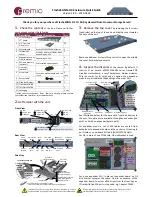
HTTP/HTTPS
W
EB
GUI
–
W
EB
B
ROWSER
C
ONFIGURATION
I
NTERFACE
8030HEPTA/GPS GPS - NTP Time Server with 2x 10/100/1000 MBit LAN Interface - V04.00
68 / 178
hopf
Elektronik GmbH
Nottebohmstr. 41
• D-58511 Lüdenscheid • Tel.: +49 (0)2351 9386-86 • Fax: +49 (0)2351 9386-93 • Internet: http://www.hopf.com • E-Mail: [email protected]
8.3.2.6 Routing File
In order to activate this function,
Use Route File
must be set to
enabled
on the Routing Page.
The routing file also makes it possible to configure IPv6 routes.
Via the selection window under Update file and the button Upload now a new routing file can
be uploaded. When uploading the file is checked whether the file is error-free and only then it
is used.
If a routing file has already been uploaded, the uploaded routing file can be downloaded under
Download Routing File
.
Routing File Syntax
Each line of the routing file must be either a valid routing line or a comment line. A comment
line starts with a hash sign (#) and can contain any text behind it.
A routing line has the format [destination address] [tab] [length of the destination mask in bits]
[tab] [gateway address for the specified destination].
If the host 192.168.20.11 is to be reached using the gateway 192.168.0.2, then the routing file
must look like this:
192.
168
.20.11
32 192.168.0.2
Example of a Routing File:
# Host 192.168.20.11 via Gateway 192.168.0.2
192.168.20.11
32 192.168.0.2
#Net 192.168.180.0 Netmask 255.255.255.0 via Gateway 192.168.0.2
192.168.180.0
24 192.168.0.2
#Net 2001:0db8:0:f102:: Subnet Prefix Length 64 via Gateway 2001:0db8:0:f101::1
2001:0db8:0:f102:: 64
2000::1
Current
System Routing Table
This table shows all active IPv4 and IPv6 routes.
For IPv6 routes, the colons of the destination and gateway addresses are not displayed, and
the
Network Mask
column displays the length in hexadecimal
















































